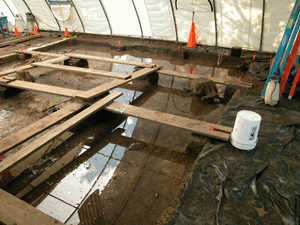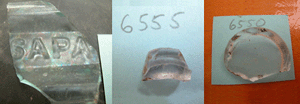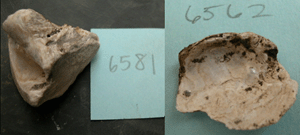This update is being provided by the students of Heidelberg College’s Archaeological Field School 2006.–Dr. Dave Bush
In the past two weeks, we have recovered numerous artifacts that merit further attention. However, our efforts were hampered by several days of flooding in the excavation units. The deeper units were filled with several centimeters of water for two days, and while the water was removed with an electric pump, the features were smeared and covered in a new layer of silt. Because of this, we had to re-scrape the units to regain the contrast of the features against the undisturbed clay subsoil. In the meantime, we continued work on the newer, shallower unit.

Flooded trenches had to be cleaned up once we pumped the water out.
Ammunition and Weaponry

Large and small shot suggest some guards at Johnson's Island carried old smoothbore muskets; at right, a percussion cap. The large shot may have been deliberately carved.
During the Civil War, both Federal and Confederate forces were equipped with various muzzle-loading weapons. The more outdated smoothbore muskets (.69 caliber) saw widespread use early in the war and among many Confederate units. More common were the .58 caliber Enfield and Springfield rifled muskets. Innovations in design, chiefly the rifling of the bore to create a spin on the bullet, made these weapons more accurate than the smoothbores. Both weapons used ammunition in the form of paper cartridges filled with powder and a projectile. The smoothbore muskets were loaded with a single large ball and three smaller shot. The more modern rifled muskets fired a single projectile, the Minie Ball, named for its inventor, Claude Minie. Both types of weapons used percussion caps to ignite the powder charge in the bore.
Since our last update, we have recovered several weapon-related artifacts. Among these were a spent percussion cap, a single lead shot and a musket ball. These last two, which are characteristic of the older smoothbore muskets, present us with several possible interpretations. First, it may indicate that at least some of the federal guards were armed with the more antiquated muskets. Though unlikely, because prisoners of war (POWs) were searched thoroughly, it is also feasible that the bullets came into the camp on the person of a Confederate prisoner. Lastly, since we are excavating the location of the camp hospital, it is possible that the projectiles may have been removed from an injured POW. This would also confirm the idea that Union guards were armed with this type of weapon. Numerous diary entries refer to guards shooting prisoners attempting to escape or guards shooting into the compound at only slight provocations. The musket ball, however, shows no signs of being fired, and so it is unlikely that it was removed from a wounded prisoner.
Crafted Items
The most notable feature of the musket ball recovered at the site is its intentional modification. It has a large arc removed from it, and a small “x” carved into one side. Several crafted lead bullets have been recovered from the site in the past. This particular bullet may have been in the initial stages of crafting when it was abandoned. As mentioned, it shows no signs of being fired, either before or after crafting.
Prisoners frequently mention crafting items for entertainment and monetary gain. Other crafted pieces recovered recently include cut shell and hard rubber artifacts. The manufacturing process for hard rubber (alternatively known as gutta percha and India Rubber) was patented by Charles Goodyear in 1851, and the product was essentially the period equivalent of plastic. When recovered, it is dark brown. Crafted hard rubber items include rings, buttons, and metal set into hard rubber as jewelry. One of the hard rubber artifacts we found recently bore “an” and “51” marks on the rear. These indicated a marking by the “American” Rubber Company, and the requisite patent mark for Goodyear’s process (“1851”). The original item that bore these marks would have been modified by a prisoner as part of the crafting process. The cut shell that we have found is often quite small, but recently we recovered a very large crafted marine shell piece, indicating that the prisoners had at least limited access to ocean shells for use in crafting.
On April 18th, 1864, Lt. William Peel of the 11th Mississippi, a prisoner at Johnson’s Island, wrote:
“I have finished some trinkets which I design sending to Miss Dora, in return for the nice shell she sent me the other day. They are a breast pin; – which is also to answer the purpose of a chain hook – a watch chain with two charms, a plain Cross, made of the Conch shell + a little fish, made of the other shell. The pin is of gutta-percha, with a D of that beautiful shell set in it. I flatter myself that they make a rather handsome present. I shall send them off soon.”
Thomas Jeter, of Virginia, another prisoner, wrote in May of 1864 that he “finished ring with Silver leaves & double hearts” on the 17th, “finished ring with gold leaves and acorn” on the 19th, and “finished rings with locked hands” on the 21st.
Medicine Bottles

Glass fragments we've recovered include pieces from a bottle labeled "sarsaparilla" (left) and colored medicine bottles (center and right).
We have also recovered numerous pieces of medicine bottles, as befits the hospital location. Recently removed was a large embossed piece bearing the letters “SAPA.” This is part of an embossed label of a “SARSAPARILLA” (pronounces “sasparilla”) bottle. Sarsaparilla is a root extract, and was commonly used in the period for its anti-inflammatory properties. It is likely that the bottle piece was originally part of a large patent Sarsaparilla medicine bottle. Other notable pieces we have recovered include several bases, and numerous glass pieces with solarized-manganese induced color, indicative of medicinal contents.



